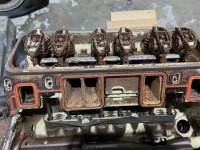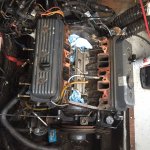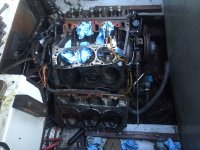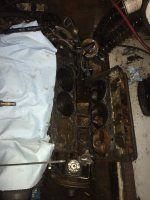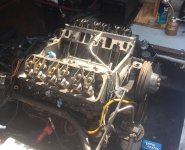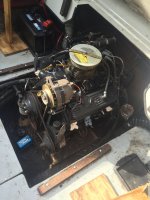loco
Petty Officer 2nd Class
- Joined
- Apr 25, 2010
- Messages
- 154
Hi all, this story goes back a couple years now. I'll try to compress the background as much as possible. Engine is a 4.3L V6 vortec. Raw water cooled.
- had leaky inlet manifold (vacuum leak, not water). Had manual provided by engine supplier for non-vortec model and over-torqued inlet manifold bolts.
- Replaced inlet manifold gaskets myself.
- Still got water in oil. Fair amount of time had passed. Took it to shop. They took engine out, replaced cylinder heads, cleaned out milky oil. Engine made loads of smoke/steam from breathers and sounded hot (ticking when we shut it down, though water temp was OK). Shop said big end bearings must be shot.
-Best part of a year has passed and we have a new long engine to go in. Taking the old engine apart, it looks like it's come up from the seabed, horribly rusted again, and with signs of water on both the inlet and exhaust sides. It's literally had about 2 hours of run time since the top half was rebuilt.
So, from the old engine, I'm only reusing the inlet manifold, carb and ancillaries. The rest is all new.
I'm just worried that the inlet manifold might be damaged, though the engineer says he cleaned it all up and it looked absolutely fine. I've asked them to do a pressure test on the coolant side before he puts the engine back in.
Any other thoughts on why the engine would look like this after having been professionally rebuilt, with new cylinder heads? any other tests I should do before, too? I'm thinking I'll have them run it on a hose for some time too before it goes back in the water and confirm no water appears in the oil.
- had leaky inlet manifold (vacuum leak, not water). Had manual provided by engine supplier for non-vortec model and over-torqued inlet manifold bolts.
- Replaced inlet manifold gaskets myself.
- Still got water in oil. Fair amount of time had passed. Took it to shop. They took engine out, replaced cylinder heads, cleaned out milky oil. Engine made loads of smoke/steam from breathers and sounded hot (ticking when we shut it down, though water temp was OK). Shop said big end bearings must be shot.
-Best part of a year has passed and we have a new long engine to go in. Taking the old engine apart, it looks like it's come up from the seabed, horribly rusted again, and with signs of water on both the inlet and exhaust sides. It's literally had about 2 hours of run time since the top half was rebuilt.
So, from the old engine, I'm only reusing the inlet manifold, carb and ancillaries. The rest is all new.
I'm just worried that the inlet manifold might be damaged, though the engineer says he cleaned it all up and it looked absolutely fine. I've asked them to do a pressure test on the coolant side before he puts the engine back in.
Any other thoughts on why the engine would look like this after having been professionally rebuilt, with new cylinder heads? any other tests I should do before, too? I'm thinking I'll have them run it on a hose for some time too before it goes back in the water and confirm no water appears in the oil.
Attachments
Last edited:




















